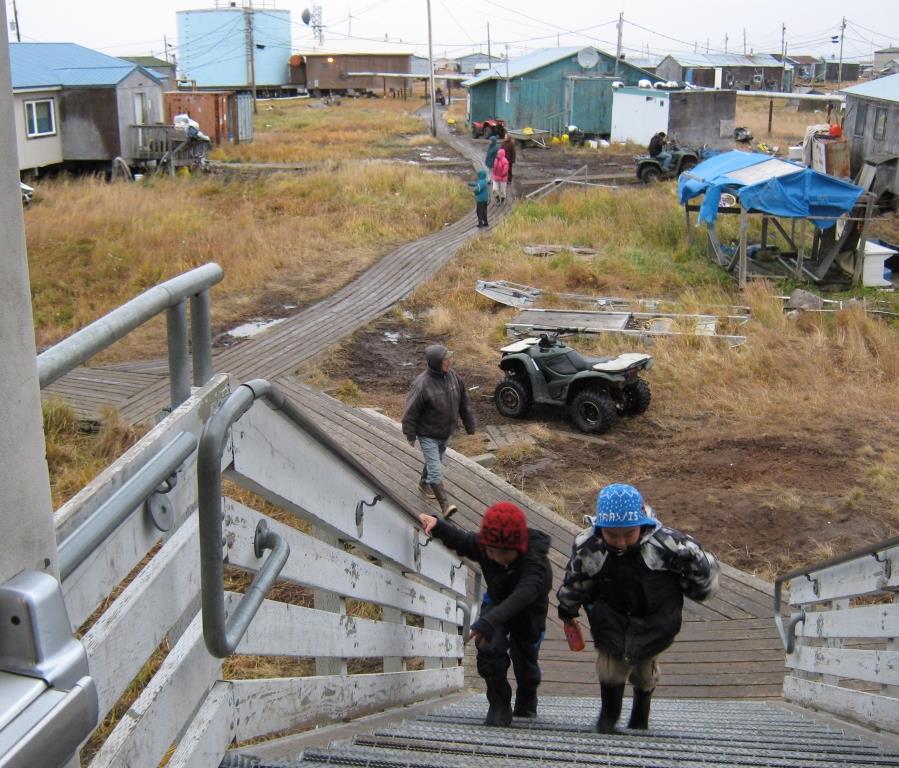Alaska villages chosen for federal relocation grants were singled out for climate-change threats — and progress
Newtok and Napakiak will each get $25 million to fund relocation projects.

Grants awarded to tribal governments in Alaska and the Lower 48 are only a start in what is expected to be a long process of funding relocation of Indigenous communities that are threatened by climate change, a top Interior Department official said Thursday.
Interior on Wednesday announced that tribal governments in the Yup’ik villages of Newtok and Napakiak, both in unstable locations undermined by erosion, flooding and permafrost thaw, and the Quinault Indian Nation in Washington state, which is threatened by flooding, will each get $25 million to fund relocation projects. Additionally, eight other tribal governments, four of which are in Alaska, were each awarded $5 million grants to help plan for relocation or other forms of climate resilience.
Selecting the three communities that received the $25 million grants was a process that considered a variety of factors, including community consensus, community readiness and progress to date, said Bryan Newland, assistant Interior secretary for Indian Affairs.
A key factor in the selection, Newland said in a telephone interview Thursday, was finding communities that would serve as “blueprints” for future relocation work elsewhere. Interior officials were “looking into our ability to learn some lessons here on the federal side so that when we do this again, we can do it more effectively and efficiently,” he said. The hope is that future relocation work becomes quicker and less expensive, he said.
“We know that there are more communities out there that have a need for this,” he said. “We just don’t have the funds available to do this for every community that needs this right now.”
The grants are paid for with $115 million in funding authorized by the Infrastructure Investment and Jobs Act passed last year. In addition, $17.7 million from the Federal Emergency Management Agency and $2 million from the Denali Commission will pay for additional work, Interior said. They were announced on Wednesday, the first day of the two-day 2022 White House Tribal Nations Summit.
The Alaska communities chosen for the grants are among the most at-risk communities in the state. Newtok, on the Ninglick River, is losing about 70 feet of land a year to erosion, while Napakiak, on the Kuskokwim River, is losing 25 to 50 feet a year, according to Interior.
Of the numerous climate-threatened Alaska communities where residents are considering relocation, Newtok is farthest along in the project. After nearly two decades of work, the community has established a new and more stable site, called Mertarvik, where residents are already living. There were 28 new homes built in Mertarvik as of last spring, with several more to be completed by year’s end. Also already in service at the new site are a road, a landfill and a sewage treatment plant.
But completing all the partial or full relocations for all the Alaska communities that need them could cost $5 billion over 50 years, according to a 2020 Bureau of Indian Affairs report.
Money to address the village problems stemming from climate change has flowed into Alaska over the past years, but it has been sporadic, from varying sources and for multiple purposes aside from relocation.
From 2016 to 2020, federal agencies spent nearly $400 million to repair infrastructure and enhance protections in several threatened villages, according to a Government Accountability Office report issued earlier this year.
In March, the U.S. Department of Agriculture included six Alaska Native villages, mostly in the Yukon-Kuskokwim region, in a series of national grants totaling $166.5 million for relocating homes and buildings out of harm’s way. That sum, also from the Infrastructure Investment and Jobs Act, was spread among 108 projects in 23 states, including those in the six selected Alaska villages: Alakanuk, Golovin, Kotlik, Kwigillingok, Tuntutuliak and Tununak.
In all, there are dozens of communities that could need some type of relocation work.
A 2019 study conducted for the Denali Commission found that 29 remote Alaska communities were at high risk for erosion, 38 were at high risk for flooding and 35 were at high risk for permafrost thaw — with some of those listed villages facing a combination of risks.
This story was first published by Alaska Beacon and is republished here under a Creative Commons license. You can read the original here.
This article has been fact-checked by Arctic Today and Polar Research and Policy Initiative, with the support of the EMIF managed by the Calouste Gulbenkian Foundation.
Disclaimer: The sole responsibility for any content supported by the European Media and Information Fund lies with the author(s) and it may not necessarily reflect the positions of the EMIF and the Fund Partners, the Calouste Gulbenkian Foundation and the European University Institute.
